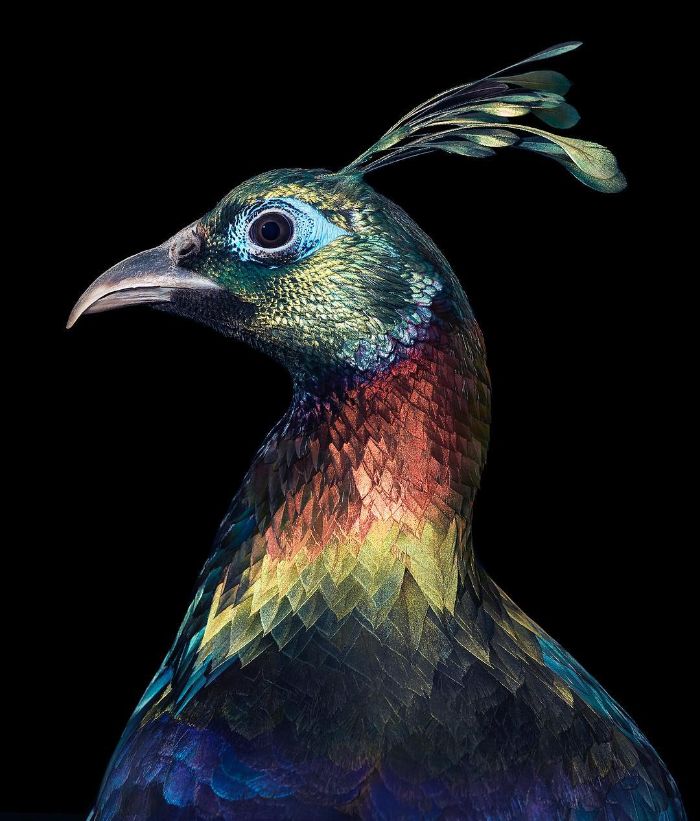Photographer Tim Flach has three goldfish and two Burmese cats. The latter, Hunt and Blue, eagerly keep their owner company while he works, even though they would probably gladly devour some of his subjects.
Flach is known for his striking portraits, where animals are treated with the same care as any human model. The photographer has captured both wild and domesticated animals, but whether he places them against a plain background or meets them in their natural habitat, Flach always manages to highlight their unique appearance.
#1
The Himalayan Monal

The Himalayan Monal is the national bird of Nepal.
As you can imagine, working with so many models requires not only artistic but organizational skills as well. Flach spends quite a bit of time on his photoshoots. "It really depends on the kind of project I'm doing," he told Bored Panda. "If I'm doing a commission, and say, I'm most likely to be photographing a domestic animal like a cat or dog, then I probably work through a wrangler or handler because at that point, everything needs to be confirmed with the agency and the client."
"But when I work on my own personal projects, it's often that I'm following a concept or an idea. And that animal then is to represent that," the photographer explained. "Then the next question is, how do I access those animals? Well, then, of course, I have to take the situation, case by case. For example, if I want to access an endangered Saiga that can only be found in some national park near the Caspian Sea in Russia, then, of course, I have to get my friend in Moscow to organize something with the national park to get some kind of permission and visa."
#2
Blue Tit
Blue Tits are a common sight at bird tables in the U.K. Researchers found that the British put double the food in bird feeders than our European neighbours, which they believe is contributing to some bird species developing longer beaks.
The next thing is having someone on the ground who actually knows what the behavior of those animals is. In the case of a particular project Flach is working on now, a book on birds, he has a guy who's like a producer and is highly knowledgeable about birds, and even owns some. Then, the photographer has to develop a case by case approach as to whether those birds could be put into an aviary in the studio, whether there's some kind of permission he has to get through a zoo, and so on. "I have to present a kind of case for why I want to get that access to them. For example, at the moment, I'm trying to get access to a very rare fossil. That fossil is unique, and I have to have a conference call with various people at the museum to convince them that it's worth me having access to such an extraordinarily rare and important fossil."
#3
Inca Tern
This for me, is the Salvador Dali of the bird world. When it comes to the length of the Peruvian Inca tern’s moustache, longer is healthier. A longer moustache indicates a stronger immune system and therefore a more attractive proposition for courtship.
So naturally, Tim's photoshoots are incredibly varied. "I think the one thing as a photographer is that though you can have your kind of formulas and approaches to certain problem solving, when it comes to the animals, each can have different situations whether that means diving with hammerhead sharks, or tracking down polar bears in the Arctic, or penguins as I did in the Antarctic last Christmas. That's slightly different than my models in the studio."
The vast majority of animals Flach photographs are untrained, including birds. "With a bird book, I might have over 100 birds, and yes, the parrots and the ones for shows, of course, they're quite trained but for the vast majority of my animals, I'm there, literally perched behind a hideout with an 800mm lens, waiting for something just to turn in my direction."
#4
The Gouldian Finch
In the studio, of course, the process is quite different. The photographer has a special aviary which makes it impossible for the animal to see him. There's even a turntable. "Often, the birds are happily perched on this and it whizzes in circles, so I can get the exact angle I want. The opportunities where I can have control and how much control can vary enormously."
Tim says there is a sense of awe and wonderment in the uncertainty of photographing animals; you never fully know what will reveal itself in front of the lens. And that is the beauty of his work; he doesn't force anything, instead, Tim allows his subjects to speak and gives the viewers space to make up everything else.
#5
Silver Laced Polish Chicken
#6
Northern Red Cardinal
#7
Major Mitchell
#8
The Philippine Eagle
#9
Jacobin Pigeon
#10
Longtail Broadbill
This long-tailed broadbill can be found from the Himalayas to South East Asia. He reminds me of a fighter pilot - but a lot of you seem to think he looks like Elvis - with his helmet-like black cap and sleek blue patch on their crown.
#11
Black Jacobin Pigeon
The Jacobin received its European name because it’s hood of feathers resembles the garments worn by the Jacobin order of monks. For others it resembles a lady in feathery clothing.
#12
Victoria Crowned Pigeon
The Victoria Crowned Pigeon is considered the largest of the living pigeon species, and can be found on mainland New Guinea. The only larger member of the pigeon family would have been the Dodo.
Silver-Laced Rooster
“This Silver-Laced rooster has come to symbolise, in Polish literature and art, a country gentleman from medieval Poland. I took this photograph at the Federation Championship Poultry Show last week.”













تعليقات
إرسال تعليق